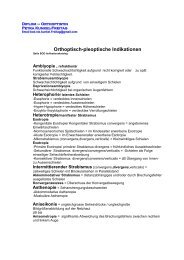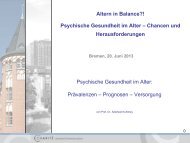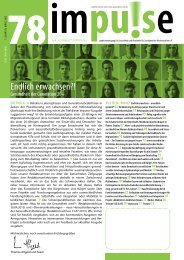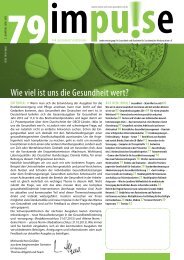Risks and Health Effects from Tattoos, Body Piercing and Related ...
Risks and Health Effects from Tattoos, Body Piercing and Related ...
Risks and Health Effects from Tattoos, Body Piercing and Related ...
Create successful ePaper yourself
Turn your PDF publications into a flip-book with our unique Google optimized e-Paper software.
Final draft –– 05.05.2003 - Review of risks <strong>and</strong> health effects <strong>from</strong> tattooing/piercing practices<br />
have engaged in risk-taking behaviours <strong>and</strong> at greater degrees of involvement than those<br />
without either. These included disordered eating behaviour, gateway drug use, hard drug<br />
use, sexual activity, <strong>and</strong> suicide. Violence was associated with males having tattoos <strong>and</strong><br />
with females having body piercings. Gateway drug use was associated with younger age of<br />
both tattooing <strong>and</strong> body piercing. Hard drug use was associated with number of body<br />
piercings. Suicide was associated with females having tattoos <strong>and</strong> younger age of both<br />
tattooing <strong>and</strong> body piercing. <strong>Tattoos</strong> <strong>and</strong> body piercings were found to be more common in<br />
females than males. In summary the authors contend that tattoos <strong>and</strong>/or body piercings can<br />
alert practitioners to the possibility of other risk-taking behaviours in adolescents, leading<br />
to preventive measures, including counselling. Tattoo <strong>and</strong> body piercing discovery should<br />
be an important part of a health maintenance visit to best direct adolescent medical care.<br />
Another report 81 sought to determine the prevalence <strong>and</strong> sociodemographic characteristics<br />
of tattooed adolescents in a nationally representative sample <strong>and</strong> to evaluate the<br />
association between tattooing <strong>and</strong> several high-risk behaviours. Within a secondary<br />
analysis of the National Longitudinal Survey of Adolescent <strong>Health</strong> Public Use Dataset<br />
(which provides a nationally representative sample of 6072 adolescents collected in 1995<br />
<strong>and</strong> 1996), the association among permanent tattoos, sociodemographic factors, <strong>and</strong> highrisk<br />
behaviours was evaluated. Of the total sample of youths, 4.5% reported having<br />
permanent tattoos. Permanent tattoos were found to be strongly associated with high-risk<br />
behaviours among adolescents. In the clinical setting, the presence of a tattoo noted during<br />
clinical examination of an adolescent should prompt in-depth assessment for a variety of<br />
high-risk behaviours.<br />
A very recent study 82 surveyed a cohort of 550 military recruits using a modification of the<br />
Youth Risk Behavioral Survey (YRBS), a validated instrument used to assess health risk<br />
behaviours in adolescents. All individuals entering basic training in the US Marine Corps<br />
or the US Air Force <strong>from</strong> June through September 1999 were eligible to participate. The<br />
primary outcome variables of interest were tobacco use, alcohol use, seatbelt use, suicidal<br />
behaviours, depression, <strong>and</strong> physical violence. The survey response rate was 91% (n = 499<br />
of 550). Overall, 27% of respondents had tattoos (n = 125) when entering military service.<br />
Women entering military service were more likely to have a tattoo than men. Controlling<br />
for age <strong>and</strong> gender, individuals with tattoos were more likely to smoke, drink heavily, use<br />
smokeless tobacco, <strong>and</strong> ride in a vehicle with someone who had been drinking than nontattooed<br />
individuals. In a population of military recruits, tattoos were associated with<br />
predictable adverse health-risk behaviours. This represents an important opportunity for<br />
targeted preventive counselling.<br />
81<br />
Roberts TA, Ryan SA: Tattooing <strong>and</strong> high-risk behavior in adolescents, Pediatrics 2002 Dec;110(6):1058-<br />
63<br />
82<br />
Stephens MB: Behavioral risks associated with tattooing, Fam Med 2003 Jan;35(1):52-4<br />
28














![PDF-Datei [780 KB] - Landesvereinigung für Gesundheit und ...](https://img.yumpu.com/22345117/1/184x260/pdf-datei-780-kb-landesvereinigung-fur-gesundheit-und-.jpg?quality=85)


![PDF-Datei [295 KB] - Landesvereinigung für Gesundheit und ...](https://img.yumpu.com/21929423/1/184x260/pdf-datei-295-kb-landesvereinigung-fur-gesundheit-und-.jpg?quality=85)